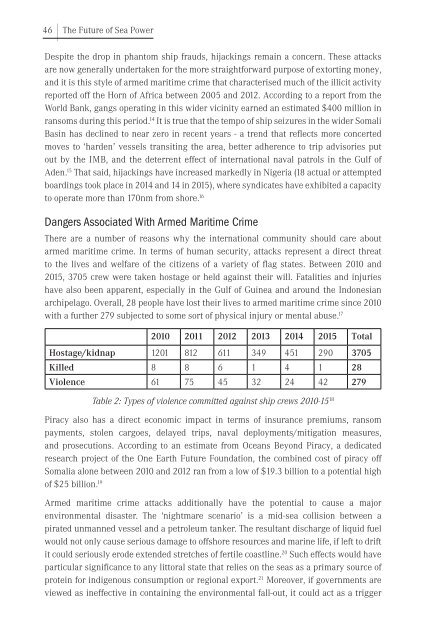THE FUTURE OF SEA POWER
SPC2015_Proceedings
SPC2015_Proceedings
You also want an ePaper? Increase the reach of your titles
YUMPU automatically turns print PDFs into web optimized ePapers that Google loves.
46 |<br />
The Future of Sea Power<br />
Despite the drop in phantom ship frauds, hijackings remain a concern. These attacks<br />
are now generally undertaken for the more straightforward purpose of extorting money,<br />
and it is this style of armed maritime crime that characterised much of the illicit activity<br />
reported off the Horn of Africa between 2005 and 2012. According to a report from the<br />
World Bank, gangs operating in this wider vicinity earned an estimated $400 million in<br />
ransoms during this period. 14 It is true that the tempo of ship seizures in the wider Somali<br />
Basin has declined to near zero in recent years - a trend that reflects more concerted<br />
moves to ‘harden’ vessels transiting the area, better adherence to trip advisories put<br />
out by the IMB, and the deterrent effect of international naval patrols in the Gulf of<br />
Aden. 15 That said, hijackings have increased markedly in Nigeria (18 actual or attempted<br />
boardings took place in 2014 and 14 in 2015), where syndicates have exhibited a capacity<br />
to operate more than 170nm from shore. 16<br />
Dangers Associated With Armed Maritime Crime<br />
There are a number of reasons why the international community should care about<br />
armed maritime crime. In terms of human security, attacks represent a direct threat<br />
to the lives and welfare of the citizens of a variety of flag states. Between 2010 and<br />
2015, 3705 crew were taken hostage or held against their will. Fatalities and injuries<br />
have also been apparent, especially in the Gulf of Guinea and around the Indonesian<br />
archipelago. Overall, 28 people have lost their lives to armed maritime crime since 2010<br />
with a further 279 subjected to some sort of physical injury or mental abuse. 17<br />
2010 2011 2012 2013 2014 2015 Total<br />
Hostage/kidnap 1201 812 611 349 451 290 3705<br />
Killed 8 8 6 1 4 1 28<br />
Violence 61 75 45 32 24 42 279<br />
Table 2: Types of violence committed against ship crews 2010-15 18<br />
Piracy also has a direct economic impact in terms of insurance premiums, ransom<br />
payments, stolen cargoes, delayed trips, naval deployments/mitigation measures,<br />
and prosecutions. According to an estimate from Oceans Beyond Piracy, a dedicated<br />
research project of the One Earth Future Foundation, the combined cost of piracy off<br />
Somalia alone between 2010 and 2012 ran from a low of $19.3 billion to a potential high<br />
of $25 billion. 19<br />
Armed maritime crime attacks additionally have the potential to cause a major<br />
environmental disaster. The ‘nightmare scenario’ is a mid-sea collision between a<br />
pirated unmanned vessel and a petroleum tanker. The resultant discharge of liquid fuel<br />
would not only cause serious damage to offshore resources and marine life, if left to drift<br />
it could seriously erode extended stretches of fertile coastline. 20 Such effects would have<br />
particular significance to any littoral state that relies on the seas as a primary source of<br />
protein for indigenous consumption or regional export. 21 Moreover, if governments are<br />
viewed as ineffective in containing the environmental fall-out, it could act as a trigger


